Serverless computing has emerged as a new rising star in the cloud computing industry. The adoption of the new paradigm is high particularly due to the demand for greater agility and distributed workloads support.
In 2020, the global serverless architecture market was valued at USD 7.6 billion, and it is projected to grow at a healthy CAGR of 22.7% and reach USD 21.1 billion by 2025. The graphic below is based on the report by Inkwood research and showcases the serverless market forecast.
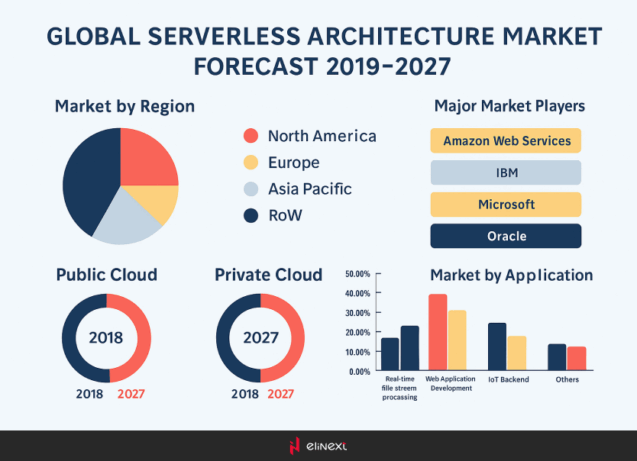
So, what is serverless computing and why is it so popular? In this article, you’ll find answers to these and many other popular questions about serverless computing so that you can have a complete picture.
1.What is serverless computing?
Serverless computing is also known as serverless architecture or simply serverless. This is basically a cloud computing execution model where machine resources are provided automatically and on-demand for an application to run or in response to an event. Unlike the traditional server-based approach to the cloud, serverless offloads all operational tasks like provisioning, scaling, scheduling, and more to the cloud provider.
2. Who pioneered serverless?
Although attempts to introduce serverless computing offerings have been made since 2006, they were not commercially successful. It is considered that the modern age of serverless began in 2014 with Amazon launch of AWS Lambda.
3. Does serverless mean no servers?
Notwithstanding the name, servers are still used to run the code but they are hosted and managed by cloud providers. The term “serverless” describes the overall experience of customers who do not manage or interact with servers.
4. How does serverless computing work?
With serverless computing, a cloud provider allocates compute storage and resources while taking care of configuration, maintenance, management of virtual machines, containers as well as physical servers.
5. Is serverless the same as cloud?
Cloud computing is a broader term that encompasses several types of delivering computing services. In addition to serverless computing, cloud also includes IaaS, PaaS, and SaaS models.
6. What is the cost model for serverless architecture?
Serverless customers pay only for the resources required to run their applications and only when these applications are running. Some providers offer granular billing and break their charges down to 100-millisecond increments.
7. What are the benefits of serverless architecture?
As discussed earlier, one of the main advantages of going serverless is reduced costs since there is no need for always-on servers. Companies can also benefit from unlimited cloud scalability, greater flexibility, and faster deployments, which translates into accelerated innovation and faster time to market. The graphic below shows the main benefits of adopting serverless computing within an organization.
Source: Newrelic
8. Are there any limitations or disadvantages?
Potential drawbacks that businesses must consider before switching to serverless include performance issues caused by cold starts since the code is not running when you are not using the application. Debugging can also be harder because every time a serverless instance spins up, it creates a new version of itself, which makes it difficult to collect data to fix the issue. Then, as with any third-party service, there is an issue of possible vendor lock-in and app migration from other platforms.
9. What are the top serverless platforms?
Ever since the first success of AWS Lamda, the serverless market has been evolving with new advanced platforms and frameworks coming up. However, AWS Lambda still holds the largest market share favored by as much as 53% of organizations. The top 5 platforms also include Azure Functions, Google Cloud Functions, IBM Functions, and Netlify.
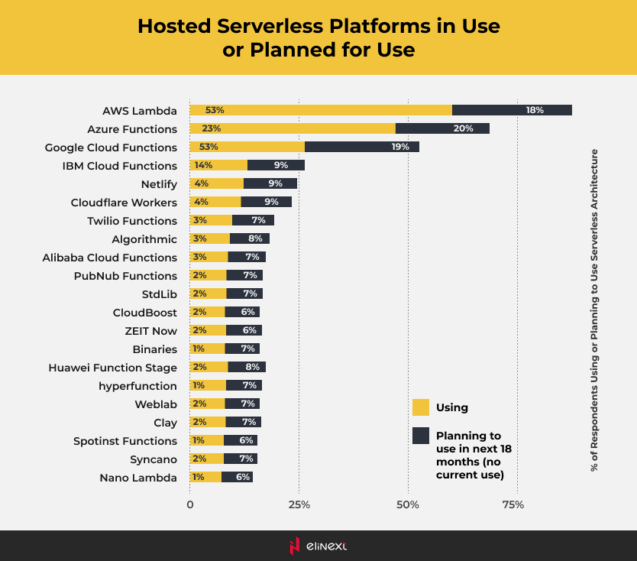
10. What is an example of a serverless application?
Many tech giants rely on serverless technology to benefit from scalability, agility, and cost savings. One such example is Slack and its Marbot that forwards alerts from AWS to DevOps teams. Marbot has even won the Serverless Slack Bot Hero Award at the AWS Serverless Chatbot Competition. Coca-Cola too has embraced serverless to streamline operations and reduce costs. Now, whenever a customer purchases a beverage, a vending machine makes a call to the AWS API gateway and triggers an AWS Lambda function to complete the transaction. This allowed the company to cut down costs from $13000 to $4.500 per year.
11. What are the most common use cases for serverless?
A recent IBM survey showed that enterprises use serverless technology for a variety of applications — from customer relationships management to enterprise resource planning.
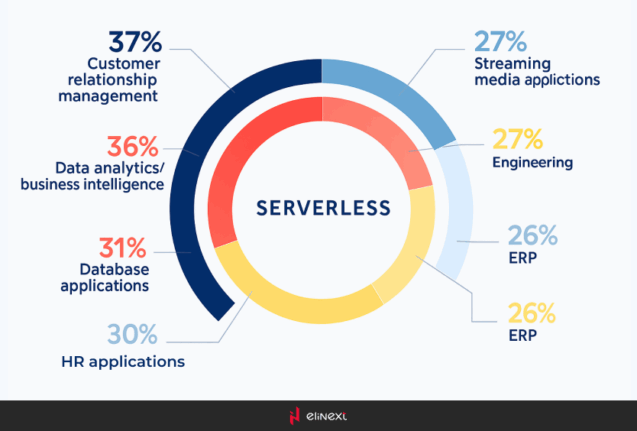
12. How secure is serverless computing?
Security, in fact, is one of the top concerns for IT professionals since there is a certain gap in serverless security knowledge compared to traditional solutions. The modular nature of serverless applications can result in an increased attack surface. And since data continuously moves between third-party components and serverless functions, it is exposed to potential interception. Recently, researchers have discovered a new vulnerability in Azure Functions, which allows an attacker to escalate privileges and escape to the Docker host, gaining root access.
13. Are there any challenges to serverless adoption?
Like with any new technology, there are certain barriers to the adoption or expansion of serverless computing within an enterprise. In addition to security concerns, IT professionals cite the complexity of serverless architectures, lack of expertise, and high costs for applications with long-running processes as main challenges.
14. What industries use serverless more?
While enterprises from different verticals and industries leverage serverless computing, the largest growth is expected in the IT and telecom, healthcare, retail, and financial services sectors.
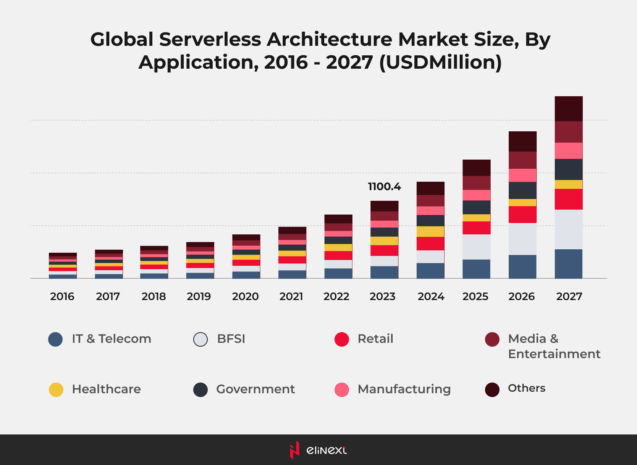
15. Which programming languages to use for a serverless application?
Major cloud vendors support a variety of languages so that developers can choose. For example, AWS Lambda supports Java, Go, PowerShell, Node.js JavaScript, C#, Python, and Ruby. Azure Functions embrace a wider range of languages, including Bash, Batch, C#, F#, Java, JavaScript (Node.js), PHP, PowerShell, Python, and TypeScript. Google Cloud functions can be written in Node.js JavaScript, Python, and Go. That said, over 50% of developers use JavaScript, Java, and Python.
16. What is a serverless backend?
A serverless backend is also known as Backend-as-a-Service (BaaS). This is a cloud service model where all backend functions like storage, database management, authentication, and others are shifted to the cloud so that developers easily integrate the necessary functionality without the need to manage complex backend servers.
17. What is the difference between serverless and FaaS?
Although these terms are often used interchangeably, serverless and Functions-as-a-Service (FaaS) are not the same. In fact, FaaS is a subset of serverless computing. While serverless is focused on a particular service category, e.g. database, messaging, APIs, or storage, FaaS is focused on event-driven computing paradigms involving entire application codes only being run in response to requests.
18. What are the core components of serverless architecture?
A typical architecture of a serverless solution consists of a web server, FaaS layer, security token service (STS), user authentication, and database, as shown below.
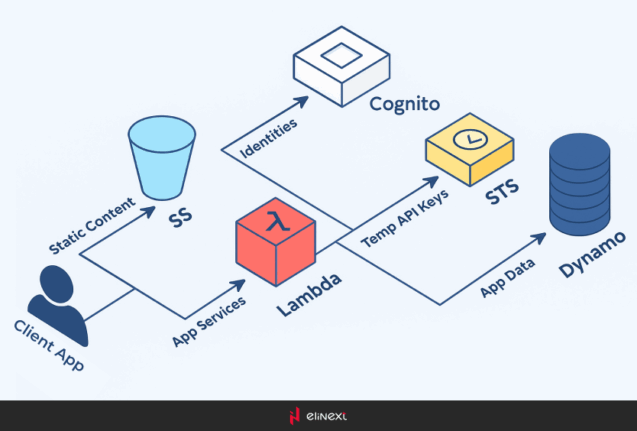
19. Kubernetes vs serverless: which is better for building cloud-native applications?
Both computing options have their pros and cons and must be carefully considered in each case. But as a rule of thumb, use serverless for irregular and variable loads, inherent auto-scalability, or when you need to test your app idea fast. Go for Kubernetes if you need minimal response latency or high performance without resource limitations.
20. What is Knative and serverless Kubernetes?
Kubernetes allows developers to build a platform for running serverless functions with the help of serverless frameworks. One such framework is Knative, an open-source platform to deploy and manage serverless workloads.
21. Is serverless better than microservices?
Serverless offers even more granularity than microservices and provides a much higher degree of functionality. Coupled with competitive pricing and enhanced scalability, serverless emerges as an attractive option. However, this granularity comes with drawbacks in the form of more complicated integration testing, debugging, and troubleshooting. Microservices, by comparison, is a more mature approach that gives developers more control over the environment, languages, and libraries.
22. Can serverless and containers work together?
Yes, and combining two technologies can help compensate for each other’s drawbacks. If you have a monolithic application that is too large for serverless, there can be small backend tasks suited for serverless functions. In a containerized system, you can run certain ancillary tasks in a serverless function to reduce the complexity of your architecture setup and benefit from the cost-efficiency of serverless.
23. Is AWS Lambda function cheaper than EC2?
It depends. For lightweight or periodic workloads, Lambda function is significantly less expensive. However, more complex tasks like ticket processing as described in recent research by Deloitte cost more to run serverless as compared to traditional server-based architecture.
24. What is the impact of serverless on DevOps?
It is unlikely that serverless computing will remove the need for DevOps or system administrators. Instead, it can take DevOps to the next level through streamlined infrastructure provisioning, flexible deployments, and DevOps automation.
25. Instead of conclusion: Is serverless hype or is it the future?
Serverless technology may still be in its infancy but it has already evolved beyond a mere buzzword. With significant investments from tech giants and startups, the serverless ecosystem keeps growing to include new players.
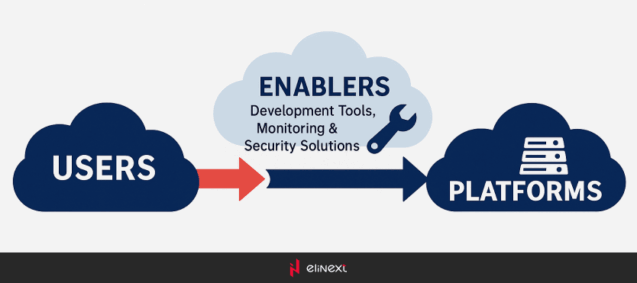
Serverless platforms allow companies to focus on innovating and developing new products, and not on maintaining infrastructure. However, serverless is not a silver bullet. Careful consideration is needed to evaluate serverless benefits and potential implementation challenges in each particular case.
Thinking to go serverless for your next development project? Elinext is a software development company with proven expertise in modern tech stack to build IT solutions of any complexity. Contact us with your project details and our experts will get back to you shortly.









